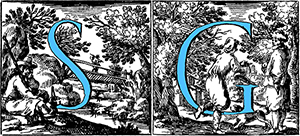The eighteenth century opens with the large series of Luca Carlevaris etchings: “Fabriche e vedute di Venetia disegnate, poste in prospettiva ed intagliate”. The work is an incomparable model in the history of Venetian view etching and it will influence the greatest painters and engravers of the eighteenth century vedutism as Marieschi, Bellotto, Canaletto and Visentini.
The main asset of Carlevaris was to represent the urban view in a poetical way. His prints are no longer only a faithful reproduction of architecture, narrow streets (calli) and canals, but they becomes the light, the air and the atmosphere of the places themselves.
Later, Michele Marieschi worked on the same “landscape etching” pathway traced by Carlevaris. Michele Marieschi was aPainter and an engraver of refined artistic taste, shows in his etchings converging diagonals in a distant background getting a stunning scenic effect.
As well as Marieschi, also Antonio Canal named “Canaletto” began his career as a “set designer” and painter before dedicating himself to engraving. He made a series of drawings representing different views of Venice and all of them were engraved, with thin and thick cuts by Antonio Visentini, architect, painter and friend of Canaletto. After this first experience Canaletto developed a very personal way to etch with parallel lines that thicken in the shadows but never cross. The result was an infinite range of blacks, variously nuanced grays and dazzling brightness. With them the artist describes the actual places of the city, of the Brenta lagoon, of Padua and also others fantastic views.
Quite soon a new figure of primary importance in the history of engraving, Giambattista Tiepolo, emerged in Venice, and it was around the middle of the century. The artist did not devote himself to landscape views, fashion of the time, but developed a very personal style in the engraving. In his works the figures have not defined contours and predominates an inexhaustible imagination. Among ancient ruins, vases and bas-reliefs, the etchings of Tiepolo show astrologers, old philosophers, magicians, soldiers, fauns, women, owls, snakes, a whole crowd of figures that are combined to make more mysterious his fantastic inventions. The graphic work of Giambattista Tiepolo, albeit small in quantity, appear as important as his painting.
In the footsteps of Giambattista also his son Giandomenico committed himself to produce high quality artistic prints with the series “Idee pittoresche sopra la fuga in Egitto” and “Teste di carattere”. Sumptuous and theatrical the first, while the second recall Castiglione Genovese style and Rembrandt inspiration. Venetian by birth and art education was also Giovanni Battista Piranesi who worked most of his life in Rome. From Tiepolo he caught the brightness, from Canaletto the parallel lines of its skies, and from Callot and Castiglione the figures distributed in close-ups.
Piranesi, architect and archaeologist, has rised up a monument to the magnificence of Rome, through his large format of etchings. The genius and the high technical expertise distinguished the immense work of engraving of this artist, who throughout his life does homage to the history and glory of Rome telling in his etchings vestiges, churches, squares, palaces, arches and columns. Piranesi does his work with the precision of a draftsman and architect, and with the imagination of the visionary. He expressed his art at the highest levels in the architectural fantasies, vagaries, and in particular in “Carceri d’invenzione”, that are full of fantastic and surreal visions elements.
Inventions, subjects of unreal fantasies and surreal depictions pervade almost all the graphic work of another great painter and engraver: Francisco Goya. Goya, in advanced age, disappointed and almost deaf, found in the printing new horizons for his art. Without any pressing by the orders of his customers, Goya granted to himself in the graphic works a greater freedom of expression, so the artist was able to express throughout his rebellion against social injustice, the classical canons of artistic tradition, the sanctimonious conventions. Ahead of its time, Goya prefers the newly discovered aquatint technique and obtains surprising tonal effects. His compositions are modern without symbols and allegories, but addressed to the stinging criticism of the decadent morality of his time, and the corrupt social order of his country. In the wide series of “Caprices”, Goya externalized all his thoughts using a satire, sometimes demonic, that spares no one.
“El sueño de la razon produce monstruos” has a literal meaning as well as the meaning of a sleeping artist that is prey of nightmares and minks. Sanctimonious people, fools, ambitious, doctors ignorant and boastful, the marriage of convenience, the greedy priests and drunkards, women deceitful and deceived, are only some of the characters of the human comedy designed by Goya in “Caprices”. The ignorance of the people, often steeped in superstition, has been mocked by Goya in many prints of the “Caprices”, as well as the cruelty of armed conflicts emerges in those of the “Miseries of war”, while the surrealist vein of the artist is expressed in the visionary compositions of the “Proverbs”.

